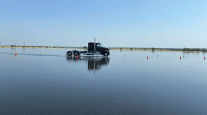Truckload Leaders Urge Changes in Assessing Value of Loads
This story appears in the March 12 print edition of Transport Topics.
KISSIMMEE, Fla. — The increasing need to conserve driver hours, coupled with the spread of electronic onboard recorders and analytical tools, are driving more fleets to adopt a new yardstick, revenue per hour, to measure productivity, industry officials said.
“We can’t just stick with the old metrics,” said Paul Will, president of Celadon Group Inc., Indianapolis, speaking on March 6 during the Truckload Carriers Association meeting here. “Revenue per day has to be changed to revenue per hour, based on utilization.”
Will said that the different approach is needed to properly price freight, particularly shorter haul and multiple-stop situations, supplementing traditional truckload metrics such as revenue per mile and revenue per day to reflect the importance of driver hours, tracked with EOBRs.
Rob Penner, chief operating officer of Bison Transport Inc., Winnipeg, Manitoba, agreed, saying, “EOBRs can give us an opportunity to view pricing in a totally different way. You have to have a good understanding of what is driving costs” to avoid steps such as a flat 5% rate increase that doesn’t necessarily fit every load.
“You have to look at the business analytically,” using EOBRs in conjunction with load optimization technology, Will said. “It’s not just running miles. We evaluate regional versus longhaul. We’re looking for opportunities that complement each other.”
Will cited an example of evaluating revenue on an hourly basis for a load running from eastern Pennsylvania to New York City, with three stops.
That couldn’t be profitable, he said, because it would consume too much time and prevent the driver from taking another load without exceeding allowable hours.
“The trucking clock is the real issue,” said Michael Gerdin, CEO of Heartland Express, citing the value of EOBRs in helping fleets to optimize driver deployments within hours-of-service rules. “Customers can tie you up for two or three hours on each end — for a 350-mile load. You can get into trouble if you price that [move] thinking you will get another load.”
Gerdin said the danger zone for pricing and utilization is moves between 300 and 450 miles that can’t be done with enough time to spare for the driver to take another load, except in “drop-and-hook” situations, where one trailer is immediately swapped for another.
Freight selection is growing in importance as shippers’ freight lanes get shorter and transit-time demands increase, Gerdin said.
Heartland Express often approaches new customers and says “give us your toughest lanes” in order to prove its high service capability, he said.
Steve Gordon, chief operating officer of Gordon Trucking, Pacific, Wash., endorsed that approach, saying “finding what [lane] is tough is how you win. If you haul the easy stuff, anybody can do that, so you are replaceable.”
As markets evolve, several said their fleets increasingly are adapting by looking outside their organizations to add needed analytical skills.
“We are looking for very strong analytical people to study the details and formulate a good strategy,” Penner said, citing the difference from decades before when freight decisions were made by “gut feel.”
Others reinforced the importance of finding the right people, often from outside the industry.
“We did that out of necessity,” Gordon said. “We had good folks around the organization, but that didn’t mean they could manage and lead.”
“We changed hiring from looking at experience to people who were ‘green’ and new to the industry,” he said, in search of workers who could communicate, think quickly and were proficient with numbers.
He noted, however, that going to universities in search of those people had pitfalls, since some larger schools thought the company was looking for truck drivers.
Aaron Tennant, CEO of Tennant Truck Lines, said the company, which specializes in hauling heavy machinery, turned to outside hires for accounting, and analytical skills.
He acknowledged that looking outside was tough for some at the family owned company to accept, but it was needed to support growth.
With added analytical skill, he said, the company could grow and improve management of its network, which had to be priced carefully because most moves were one-way with limited backhaul opportunities.




